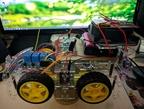IoT Electric Vehicle
- 0 Collaborators
The battery management system (BMS) needs to be improved to provide better performance. The Battery Monitoring System (BMS) is part of the BMS and is used to monitor the operating system, performance, and battery life, such as charging and discharging processes. ...learn more
Project status: Concept
Overview / Usage
The battery management system (BMS) needs to be improved to provide better performance. The Battery Monitoring System (BMS) is part of the BMS and is used to monitor the operating system, performance, and battery life, such as charging and discharging processes. The battery monitoring system is composed of measuring equipment for measuring the voltage, current, and temperature of the battery. By processing these parameters, the battery's state of charge (SOC) and the state of health (SOH) can be estimated. The Internet of Things (IoT) enables smart microgrids to share information for more users and improves connectivity in many infrastructures. Numerous studies have developed the Internet of Things for various fields and have been implemented in various fields, such as transport and logistics, environment home, office and factory, personal and public, biomedicine and energy. The Internet of Things-based Energy domain allows users to view energy consumption in real-time. One of the applications in the energy sector is the smart grid. Smart grid applications based on the Internet of Things have been developed for emergency management using smart charges. Batteries are the most important part of electric vehicles. to power the entire system, and it is important to monitor the voltage level of the battery, mainly due to improper charging and discharging of lithium-ion batteries, which is a big safety issue. Electric vehicles (EVs) have a separate system called Battery Monitoring System (BMS), which monitors all properties of the battery pack, such as voltage, current, and temperature, and ensures the safety of lithium batteries. Previously, the battery monitoring system only monitored the battery status and reminded the user through the vehicle's battery indicator. The Advances in technology have enabled the use of the Internet of Things (IoT) to remotely notify manufacturers and users of battery health. You can check the battery status of your vehicle battery on your smartphone from anywhere in the world, which is one of the maintenance supports provided by the manufacturer. Internet of Things (IoT), which is a system of interconnected physical objects system that is assigned an IP and can connect networks without manual intervention. The system also transfers data over the Internet without human-to-human, human-machine interaction. This IoT system is created by exchanging data between the server and the microcontroller on a microcontroller equipped with a WIFI chip, sensors, etc. Technology is constantly changing every second. This is based on current technologies, Battery Monitoring Systems (BMS), and the Internet of Things (IoT).
Methodology / Approach
The battery management system (BMS) needs to be improved to provide better performance. The Battery Monitoring System (BMS) is part of the BMS and is used to monitor the operating system, performance, and battery life, such as charging and discharging processes. The battery monitoring system is composed of measuring equipment for measuring the voltage, current and temperature of the battery. By processing these parameters, the battery's state of charge (SOC) and the state of health (SOH) can be estimated. The Internet of Things (IoT) enables smart microgrids to share information for more users and improves connectivity in many infrastructures. Numerous studies have developed the Internet of Things for various fields and have been implemented in various fields, such as transport and logistics, environment home, office and factory, personal and public, biomedicine and energy. The Internet of Things based Energy domain allows users to view energy consumption in real-time. One of the applications in the energy sector is the smart grid. Smart grid applications based on the Internet of Things have been developed for emergency management using smart charges. Batteries are the most important part of electric vehicles. to power the entire system, and it is important to monitor the voltage level of the battery, mainly due to improper charging and discharging of lithium-ion batteries, which is a big safety issue. Electric vehicles (EVs) have a separate system called Battery Monitoring System (BMS), which monitors all properties of the battery pack, such as voltage, current, and temperature, and ensures the safety of lithium batteries. Previously, the battery monitoring system only monitored the battery status and reminded the user through the vehicle's battery indicator. The Advances in technology have enabled the use of the Internet of Things (IoT) to remotely notify manufacturers and users of battery health. You can check the battery status of your vehicle battery on your smartphone from anywhere in the world, which is one of the maintenance supports provided by the manufacturer. Internet of Things (IoT), which is a system of interconnected physical objects system that is assigned an IP and can connect networks without manual intervention. The system also transfers data over the Internet without human-to-human, human-machine interaction. This IoT system is created by exchanging data between the server and the microcontroller on a microcontroller equipped with a WIFI chip, sensors, etc. Technology is constantly changing every second. This white paper is based on current technologies, Battery Monitoring Systems (BMS), and the Internet of Things (IoT).
Technologies Used
That particular software and hardware tools are used here because of the working as well as the different features of the particular hardware or software. Such as TP4056, The TP4056 1A Lithium-Ion Lithium Battery Charging Module with Overcurrent Protective-Mini USB is designed to charge a single 3.7V 1Ah or more Lithium-Ion (Li-on) cell, such as the 16550, without the need for its own protection circuit. It is an ultra-compact module that is ideal. This module, which uses the TP4056 Charger IC and the DW01 Battery Protection IC, offers a charging current of 1A and will turn off when the charge is complete. The TP4056 is a 1-cell lithium-ion battery charger with a complete constant-current/constant-voltage linear charger. The TP4056 is suited for portable applications due to its SOP package and minimum amount of external components. The TP4056 can also operate within the USB and AC adapter. after that another one Relay, Relay is basically an electromagnetic switch. It needs a small voltage (5v for this purpose) to trip. Total three states are present in the relay such as Normally Open (NO), Normally Closed (NC) & Common (COM), the appliances are connected to those states. A relay is a switch that uses a separate mild current to permit the electromechanical closing or opening of circuits that carry heavy current. When the relay is turned on, it connects two circuit ends and disconnects them when it is turned off. Electromechanical relays of various types all function in essentially the same way. Electromagnets, springs, mechanically moveable contacts, and switching points are the key components. Three contacts make up a basic relay. The common contact (COM) is connected to the mechanical moving contact as the first contact. The other two contacts are known as switching points and are used to connect to a high-ampere load. They are ordinarily open (NO) and typically closed (NC) contacts, respectively. Both AC and DC electricity can be used to operate the relay. Despite this, the relay coil demagnetizes during every current zero position since AC is an alternating current. As a result, the relay would constantly break the circuit, impairing the electronics’ operation. To address this issue, AC relays are designed with special features that allow them to maintain magnetism even when the current is zero. Shaded coil mechanisms and electronic circuit arrangements are two ways used to tackle this problem in AC relays. Next is ThingSpeak, ThingSpeak is a cloud-based IoT analytics platform that aggregates, visualizes, and analyses real-time cloud data streams. You can use your device to send data to ThingSpeak, build real-time visualizations of live data, and issue alarms. Sensors and actuators are examples of things. Sensors provide information about our surroundings. Consider a cell phone's temperature sensor or GPS receiver. Temperature controllers, lights, pumps, and outlets are all controlled by actuators. The "Internet of Things" connects everything and lets us interact with objects. ThingSpeak is an internet of things application platform. ThingSpeak enables us to create apps based on the data collected by the sensors. Real-time data collecting, data processing, visualization, apps, and plugins are all features of ThingSpeak. The Thing Speak channel is at the heart of the Thing Speak system. The stored data is sent across the channel. Each channel has eight fields for various data kinds, three location fields, and one status field. Getting a ThingSpeak channel allows us to send data to the channel, have it processed by ThingSpeak, and then send the data back to our application.
Repository
https://github.com/mainakgithub




